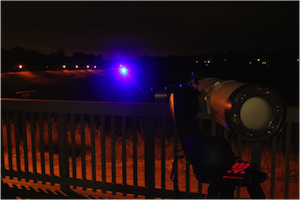OpComms System II
System II was the OpComms group's second attempt at an optical link. This system featured motorized mounts, a commercial photodetector, and an upgrade to lasers, from the earlier LED matrix of System I. This link was successful at transmitting a signal across approximately 500m.
Motorized mounts
In order to increase alignment precision, the team purchased several motorized altitude/azimuth mounts, intended for use with the Celestron Nexstar telescope system. These became pivotal in the group’s alignment strategy at long distances, due to the need for very fine adjustments.
The motorized mounts ship with an attached handpiece for direct control of the two adjustment motors. In order to gain more programmable control over the arms, however, the team created an interface to access these controls and the position readout from a computer. Two different models of mount were ultimately used; the receiving station used an arm advertised as precise to 0.5 millionths of a degree (1.5 nanoradians), while the transmitting station used a smaller arm precise to 5 thousandths of a degree (100 microradians). The receiver arm reports its position with 8 hexadecimal characters; however, only the 5 most significant actually vary in the arm’s reported position, meaning that it is really only accurate to 2π/〖16〗^5 radians, approximately 6 microradians. It is possible that this observed level of precision derives from a mechanical limitation on the step size of the motors, which implies that higher precision cannot be obtained from the system. The smaller arm used at the transmit station, while precise to the level advertised, runs an older software version and does not support all of the commands available to the receiving arm, limiting the freedom the team had in designing aligning and tracking algorithms.
Laser system
With the intent to increase the distance of transmission, the group decided to move from the LED transmitter to a blue laser system. A 5 mW blue (450 nm) laser was purchased, and a custom mounting block was designed and machined from Delrin. This was affixed to the motorized mount to allow for precise adjustment of the beam angle. Photodetector For System II, the group purchased a Thorlabs photodetector [1] to replace our homemade circuitry. This photodetector has a very large bandwidth (50 MHz) because at the time, the group was seriously considering high speed goals. These goals were not pursued, but the photodetector’s copious bandwidth remains. This instrument was used for the remainder of testing, through System III.
Telescope re-alignment and testing
The team experienced some difficulties with the optical quality of the Galileo telescope it had previously used as part of the receiver system. In troubleshooting this system, Katie Petway worked with the Stanford Astronomy Club to realign the internal mechanisms and restore linearity. During this period, the team also tested out several alternative telescopes, and found experimentally that the light each telescope transferred to the detector was primarily determined only by the inlet diameter of the telescope, and very minorly impacted by any other quality metrics of the telescopes, if at all. From this information, the team decided that the most direct way to increase optical power received by the photodetector was to scale up the size of the receiving aperture.
